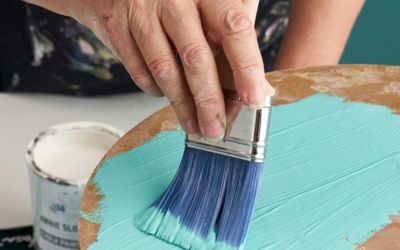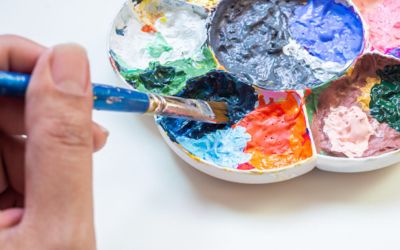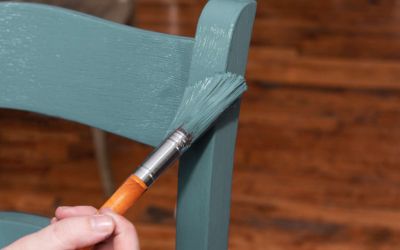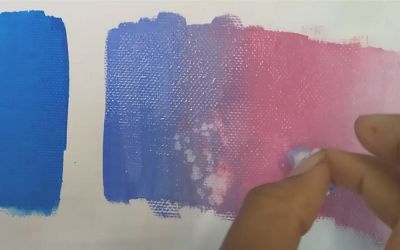Chalk paint and acrylic paint: two popular choices for artists, DIY enthusiasts, and home decorators alike. But which one is right for you and your next creative project?
This comprehensive article will explore the fascinating world of these two distinct types of paint, exploring their unique characteristics, applications, and histories.
From the charming, vintage-inspired appeal of chalk paint to the versatile, vibrant allure of acrylics, we’ll help you navigate the colorful landscape of paint options.
Get ready to uncover the differences and similarities between chalk paint vs acrylic paint and discover which will best bring your vision to life.
What is the difference between chalk paint and acrylic paint?
Chalk paint is known for its matte, chalky finish and ability to adhere to almost any surface without sanding or priming. Acrylic paint is versatile, water-resistant when dry, and can be used on various surfaces. Both have unique characteristics that make them suitable for different projects.
Chalk paint composition and properties
Chalk paint is a water-based paint that contains calcium carbonate or other natural minerals, giving it its distinct matte, chalky finish.
It also includes binders, such as latex acrylic paint, which help the paint adhere to surfaces and provide durability.
Chalk paint is known for its excellent coverage, often requiring fewer coats than other paint brands.
Its thick consistency allows for easy application, blending, and distressing.
As it dries, the paint creates a soft, velvety texture, which can be further enhanced with waxes or other finishing products to achieve a desired look.
Acrylic paint composition and properties
Pigments in acrylic paint are suspended within an acrylic polymer emulsion, giving it the unique properties of water solubility when wet and water resistance when dry.
The polymer acts as a binder, providing flexibility and adhesion to various surfaces.
Acrylic paint is available in various consistencies, from fluid to heavy-bodied, allowing artists to achieve various effects.
It dries quickly, usually within minutes, and forms a durable, flexible film that can be easily layered or blended.
Acrylic paint can be thinned with water or acrylic mediums to create transparent washes or applied thickly for impasto techniques.
Its vibrant colors and compatibility with various surfaces make it a popular choice for many art and craft projects.
Interesting Read: Why is My Paint So Watery.
Is chalk paint acrylic?
No, chalk paint is not the same as acrylic paint. Chalk paint is a type of decorative paint known for its matte finish and versatility on furniture and home decor.
It contains calcium carbonate which gives it a chalky texture. Acrylic paint, on the other hand, is a water-based paint with a fast-drying nature, made primarily of pigment suspended in acrylic polymer emulsion.
While both can be used in art and DIY projects, they have distinct properties and finishes.
Chalk Paint Vs Acrylic Paint: Side-by-Side Comparison Guide
1. Acrylic paint vs chalk paint: Coverage and opacity
Chalk paint is known for its excellent coverage and opacity, often requiring fewer coats than other paint types.
The high pigment concentration and thick consistency produce a rich, deep color with minimal effort.
However, acrylic paint can vary in coverage and opacity depending on the brand, quality, and color.
Some acrylics may require multiple coats or the addition of a medium to achieve desired opacity.
However, the transparent nature of acrylics can be advantageous for layering and glazing techniques in fine art.
Best Overall: Chalk paint for coverage and opacity.
2. Chalk paint vs acrylic paint: Drying time
Chalk paint generally dries more slowly than acrylic paint, taking anywhere from 30 minutes to a few hours, depending on humidity and paint thickness.
This slower drying time can be beneficial for blending and manipulating the paint.
Acrylic paint dries quickly, usually within minutes, which can be both an advantage and a disadvantage.
Fast drying times allow for quick layering but can make blending and wet-on-wet techniques more challenging.
Best Overall: Acrylic paint for fast drying time.
3. Acrylic vs chalk paint: Texture and finish
Chalk paint has a distinct matte, chalky finish and a velvety texture that resembles vintage and distressed styles.
Acrylic paint has a more versatile finish, ranging from matte to glossy, depending on the brand and specific product. Find out more on satin vs matte paint finish in our guide.
The texture of acrylic paint can also vary from fluid to heavy-bodied, allowing for various techniques and effects.
While both types of paint can be manipulated with additives or mediums, chalk paint’s inherent texture and finish set it apart.
Best Overall: Chalk paint for a unique matte, chalky finish; acrylic paint for versatile finishes and textures.
4. Acrylic paint vs chalk paint: Durability and longevity
Both chalk paint and acrylic paint are known for their durability once dry. Chalk paint adheres well to surfaces and becomes more durable when sealed with a wax or other protective finish.
Acrylic paint forms a flexible, water-resistant film resistant to fading and wear.
However, acrylic paint may be more susceptible to cracking or peeling on flexible surfaces, such as fabric or leather, without the addition of a specialized medium.
Both paints are generally suitable for long-lasting projects, but the specific application and surface should be considered when choosing between them.
Best Overall: Tie, depending on the specific application and surface requirements.
5. Chalk vs acrylic paint: Color Selection and blending
Chalk paint typically has a more limited color palette, focusing on muted, vintage-inspired hues.
However, chalk paint colors can be mixed and blended to create custom shades.
Acrylic paint offers many colors, including vibrant and translucent options, making it popular for artists seeking maximum versatility.
Acrylic paint can also be mixed and blended on the palette and the painting surface.
Best Overall: Acrylic paint for color selection and blending versatility.
6. Chalk craft paint vs acrylic paint: Surface preparation
One of the key advantages of chalk paint is its minimal surface preparation requirements.
Chalk paint adheres well to most surfaces without priming or sanding, making it a popular choice for furniture makeovers and home décor projects.
Acrylic paint may require more surface preparation, such as cleaning, sanding, or primer, particularly when used on non-porous or glossy surfaces.
Best Overall: Chalk paint for minimal surface preparation.
7. Sealing and finishing
Chalk paint typically requires a protective sealant, such as wax or a clear coat, to enhance durability and protect the finish from wear and tear.
Sealing chalk paint also enhances its resistance to moisture and staining, making it suitable for furniture and other surfaces that will be frequently used.
Acrylic paint does not always require a sealant, as it dries to a durable, water-resistant finish.
However, a varnish or protective coating can enhance the appearance or protect the paint from UV damage and other environmental factors.
Best Overall: Tie, depending on the desired finish and protection requirements.
8. Chalk paint or acrylic paint: Cleanup and maintenance
Both chalk paint and acrylic paint are water-based, making cleanup relatively easy.
Brushes and tools can be cleaned with water and mild soap, though cleaning them promptly is essential, particularly with acrylic paint, which dries quickly and can become difficult to remove once dry.
In terms of maintenance, chalk paint may require periodic reapplication of wax or sealant to maintain its finish, while acrylic paint is generally low-maintenance once dry and sealed.
Best Overall: Acrylic paint for ease of cleanup and low-maintenance.
9. Acrylic vs chalk paint: Cost and availability
Chalk paint can be more expensive than acrylic paint, especially considering high-quality, popular brands such as Annie Sloan.
However, many DIYers and professionals find the unique finish and ease of application worth the investment.
Acrylic paint is available in a wide range of price points, from budget-friendly craft paints to professional-grade artist acrylics.
It is typically more widely available, with options at art supply stores, craft stores, and online retailers.
Best Overall: Acrylic paint for cost and availability, but chalk paint may be worth the investment for specific projects and desired finishes.
Use chalk paint or acrylic paint: Comparison Table
| Factor | Chalk Paint | Acrylic Paint | Best Overall |
|---|---|---|---|
| Coverage and Opacity | Excellent coverage, fewer coats needed | Varies, may require multiple coats or additives | Chalk paint |
| Drying Time | Slower drying time (30 mins to a few hours) | Fast drying time (usually within minutes) | Acrylic paint |
| Texture and Finish | Matte, chalky finish | Versatile, matte to glossy finish | Chalk paint for a matte, chalky finish; acrylic paint for versatile finishes and textures |
| Durability and Longevity | A limited color palette, focus on muted, vintage hues | Flexible, water-resistant, resistant to fading and wear | Tie, depending on application and surface |
| Color Selection and Blending | The vast array of colors, including vibrant and translucent options | Vast array of colors, including vibrant and translucent options | Acrylic paint |
| Surface Preparation | Minimal preparation adheres to most surfaces without priming/sanding | May require cleaning, sanding, or priming | Chalk paint |
| Sealing and Finishing | Requires protective sealant (wax or clear coat) | Does not always require sealant | Tie, depending on finish and protection requirements |
| Cleanup and Maintenance | Easy cleanup, periodic reapplication of wax/sealant | Easy cleanup, low-maintenance once dry and sealed | Acrylic paint |
| Cost and Availability | More expensive, popular brands like Annie Sloan | Wide range of price points, more widely available | Acrylic paint for cost and availability, but chalk paint may be worth the investment for specific projects and desired finishes. |
Chalk Paint: Overview and History
Chalk paint is a versatile, water-based paint known for its matte, chalky finish.
It is often used for painting furniture and home décor projects, it adheres well to various surfaces, including wood, metal, and glass, without priming or sanding.
This highly pigmented paint provides excellent coverage and rich, deep color.
Its unique texture and finish make it a favorite among those seeking a vintage or distressed look for their projects.
The history of chalk paint dates back to the 1990s when British artist and designer Annie Sloan developed her eponymous brand.
Sloan formulated the original chalk paint recipe to seek an easy-to-use paint requiring minimal preparation and offering a distinctive finish.
Since then, chalk paint has become popular among DIY enthusiasts and professional furniture painters.
Annie Sloan Chalk Paint remains one of the most popular and respected brands in the market, but other manufacturers have since emerged, offering their own variations of this beloved paint.
Some notable brands include Rust-Oleum Chalked, Valspar Chalky Finish, and Valspar Chalky Finish.
Each brand offers various colors, finishes, and accompanying products, catering to different tastes and project requirements.

Acrylic Paint: Overview and History
Acrylic paint is a versatile, water-soluble medium known for its quick-drying properties and vibrant colors.
Composed of pigment suspended in an acrylic polymer emulsion, it can be used on various surfaces, such as canvas, wood, paper, and metal.
Acrylic paint is beloved by artists and crafters alike for its flexibility, as it can be thinned with water or applied thickly for different effects.
It is also suitable for mixed media and forms a durable, water-resistant surface when dry.
The development of acrylic paint can be traced back to the 1940s when the first commercially available acrylics, known as Magna, were introduced by Leonard Bocour and Sam Golden.
However, acrylics gained widespread popularity in the 1950s and 1960s when newer formulations, such as Liquitex, were launched, offering improved consistency and color range.
Today, numerous brands offer acrylic paint for varying skill levels and budgets.
Some popular manufacturers include Golden Artist Colors, Liquitex, Winsor & Newton, and Amsterdam.
These brands provide a wide selection of colors, finishes, and mediums, catering to the diverse needs of artists, hobbyists, and professionals.
Related Post: Can Acrylic Paint Be Used on MDF

What is chalk acrylic paint?
Chalk acrylic paint combines the properties of both chalk paint and acrylic paint.
It is a water-based paint that dries quickly like acrylic but has the matte, velvety finish characteristic of chalk paint.
This paint type offers the benefits of acrylic’s adhesion and durability with chalk paint’s unique texture and easy-to-distress features.
Chalk acrylic paint is often used for furniture and craft projects where users desire the chalky finish but also want the advantages of acrylic
Applications and Uses
Common uses for chalk paint
Chalk paint is predominantly used for furniture makeovers and home décor projects, such as painting cabinets, dressers, tables, chairs, and picture frames.
Its excellent adherence to various surfaces and minimal preparation requirements make it an appealing choice for DIY enthusiasts.
Waterproof chalk paint adds an extra layer of durability, allowing your creations to withstand even outdoor elements without compromising on style or quality.
The chalky finish and ease of distressing also lend themselves well to creating vintage, shabby-chic, or farmhouse-style pieces.
Common uses for acrylic paint
Acrylic paint is highly versatile and can be used for fine art, crafts, and home décor. Popular applications include painting on canvas, wood, paper, fabric, and ceramics.
Acrylic paint is also commonly used for mural painting, mixed media art, and abstract techniques due to its flexibility, quick drying time, and vibrant colors.
Learn more here: What Do You Use Acrylic Paint for?
Unique projects and ideas for each type of Paint

For chalk paint, consider exploring decorative techniques such as layering colors, creating textured finishes with brushes or sponges, or using stencils for patterned effects.
Experiment with wax finishes or glazes to achieve various looks, from antique to modern.
Try pouring techniques to create abstract fluid art with acrylic paint, use palette knives for impasto effects, or incorporate mixed media elements such as collage, ink, or pastels.
Acrylics can also be used for various craft projects, such as painting on rocks, glassware, or textiles.
The possibilities are endless, limited only by your imagination and creativity
Chalk paint vs acrylic paint for furniture
For a quick transformation with less prep, chalk paint is the winner. For durability and versatility in finish options, acrylic paint takes the lead.
Chalk paint offers a matte, vintage look and requires minimal prep, ideal for shabby chic styles.
Acrylic paint provides a durable, customizable finish and is available in various sheen
Advantages and Disadvantages
Pros and cons of using chalk paint
Pros:
- Excellent coverage and opacity, often requiring fewer coats.
- Distinct matte, chalky finish that works well for vintage and distressed styles.
- Minimal surface preparation is needed. It adheres to most surfaces without priming or sanding.
- Easy to distress and manipulate for various decorative effects.
Cons:
- Limited color palette compared to acrylic paint.
- Requires sealing with wax or a protective finish to enhance durability.
- It can be more expensive than acrylic paint, particularly in popular brands like Annie Sloan.
- Slower drying time, which may not be ideal for some projects.
Pros and cons of using acrylic paint
Pros:
- Fast drying time, allowing for quick layering and progress.
- Versatile texture and finish options, ranging from matte to glossy.
- Wide range of colors is available, including vibrant and translucent options.
- Durable, water-resistant finish, often requiring no additional sealant.
- Easy cleanup and low-maintenance once dry and sealed.
Cons:
- May require more surface preparation, such as cleaning, sanding, or priming.
- Fast drying time can make blending and wet-on-wet techniques more challenging.
- Coverage and opacity can vary, sometimes necessitating multiple coats or additives.
- May be more susceptible to cracking or peeling on flexible surfaces without a specialized medium.
FAQs
Can you use acrylic paint instead of chalk paint?
You can use acrylic instead of chalk paint, but the results will vary. Acrylic paint offers more colors and finishes, while chalk paint has a unique matte, chalky finish suited for vintage styles. Remember that surface preparation, drying time, and sealing requirements differ, so adjust your techniques and expectations accordingly.
What is so special about chalk paint?
Chalk paint is special because it offers a unique matte, chalky finish that works well for vintage and distressed styles. It also requires minimal surface preparation, as it adheres to most surfaces without priming or sanding. This makes it a popular choice for furniture makeovers and home décor projects. Additionally, chalk paint can be easily distressed and manipulated to create various decorative effects.
Why do people use chalk paint instead of regular paint?
People choose chalk paint over regular paint (such as acrylic or latex paint) for several reasons:
– The distinct matte, chalky finish is ideal for vintage and distressed styles.
– Minimal surface preparation requirements, making it easy to use for furniture makeovers and home décor projects.
– The ability to easily create unique decorative effects, such as distressing and texture.
– Excellent coverage and opacity, often requiring fewer coats than regular paint.
How can I make my own chalk paint at home?
Making chalk paint at home is easy – mix equal parts of plaster of Paris, water, and blend latex acrylic paints until smooth. Then apply it to your surface for a unique matte finish perfect for vintage or distressed styles. To enhance texture, add baking soda, or experiment with color combinations.
Conclusion
Choosing chalk paint and acrylic paint depends on each project’s unique requirements and desired outcomes.
Chalk paint is best for vintage and distressed styles, offering a matte, chalky finish with minimal surface preparation.
However, acrylic paint is versatile in colors and finishes, dries quickly, and is durable.
When considering Chalk Paint Vs Acrylic Paint, it’s essential to understand their differences, advantages, and disadvantages to make an informed decision.
By selecting the right paint type for your project, you can achieve the best results and bring your creative vision to life.
You can also DIY chalk paint with some practice and experimentation.










Leave a Reply